An Analysis of Ideological Themes in the Novel: 13 Reasons Why
VerifiedAdded on 2022/09/14
|10
|3080
|17
Essay
AI Summary
This essay provides a sociological analysis of Jay Asher's novel, '13 Reasons Why,' focusing on the ideologies embedded within the narrative. It examines how the novel portrays identity, subjectivity, and agency, highlighting themes of bullying, suicide, and the impact of social and cultural issues on young adults. The paper explores the concepts of realism and liberalism as reflected in the characters' experiences and choices, offering insights into how the novel shapes readers' values and beliefs. It further discusses the portrayal of relationships, parental dynamics, and the consequences of individual actions within a framework of cultural dimensions. The essay concludes by emphasizing the influence of literature on shaping perceptions of reality and the importance of understanding the ideologies presented in young adult fiction.

Running head: SOCIOLOGY
SOCIOLOGY
Name of the student:
Name of the university:
Author note
SOCIOLOGY
Name of the student:
Name of the university:
Author note
Paraphrase This Document
Need a fresh take? Get an instant paraphrase of this document with our AI Paraphraser

1
SOCIOLOGY
Introduction:
Every novel, every painting, every work of art designed by mankind with meaning
contains an ideology, even the stories that are written for the children. An ideology is a collection
of normative values as well as beliefs which an individual or group holds for others
(Muthukrishnan and Kelley 2017). Sometimes these rely on simple assumptions about reality
that may or may not have any factual basis (Muthukrishnan and Kelley 2017). The term
ideology is specifically used for unfolding systems of ideas as well as ideals which form the
basis of political theories. It can refer to a system of beliefs which are linked with the concept
of power (Kaniklidou and House 2018). These values and beliefs strongly incorporated in the
language which further shaped the mentality of the youth. The modern era, the ideologies
reflected through the child literature is so deep that individuals sometimes consider them as truth
(Nikolajeva 2016). This influence of ideology further shape the values and beliefs of the
individuals as the first component of the ideology is to have power on cognition. After all, a
narrative without an ideology is unthinkable. Hence. This paper is aimed to provide ideology
embedded in the depiction of identity, subjectivity, and agency of thirteen reasons
why. Thirteen Reasons Why is a well-known young adult novel that was written in 2007 by Jay
Asher, an American novelist (Asher 2007). This novel is the story of a young high school
student as she inclines into misery brought on by betrayal and bullying, ending with her suicide
(Asher 2007). In the novel, the writer highlighted that she details the thirteen reasons why she
was determined to end her life in an audio diary that is mailed to a friend two weeks after her
death. While many ideological ideas were reflected in 13 reasons why, realism is highly
prominent in the novel which further influence the thoughts, beliefs, and values of the young
SOCIOLOGY
Introduction:
Every novel, every painting, every work of art designed by mankind with meaning
contains an ideology, even the stories that are written for the children. An ideology is a collection
of normative values as well as beliefs which an individual or group holds for others
(Muthukrishnan and Kelley 2017). Sometimes these rely on simple assumptions about reality
that may or may not have any factual basis (Muthukrishnan and Kelley 2017). The term
ideology is specifically used for unfolding systems of ideas as well as ideals which form the
basis of political theories. It can refer to a system of beliefs which are linked with the concept
of power (Kaniklidou and House 2018). These values and beliefs strongly incorporated in the
language which further shaped the mentality of the youth. The modern era, the ideologies
reflected through the child literature is so deep that individuals sometimes consider them as truth
(Nikolajeva 2016). This influence of ideology further shape the values and beliefs of the
individuals as the first component of the ideology is to have power on cognition. After all, a
narrative without an ideology is unthinkable. Hence. This paper is aimed to provide ideology
embedded in the depiction of identity, subjectivity, and agency of thirteen reasons
why. Thirteen Reasons Why is a well-known young adult novel that was written in 2007 by Jay
Asher, an American novelist (Asher 2007). This novel is the story of a young high school
student as she inclines into misery brought on by betrayal and bullying, ending with her suicide
(Asher 2007). In the novel, the writer highlighted that she details the thirteen reasons why she
was determined to end her life in an audio diary that is mailed to a friend two weeks after her
death. While many ideological ideas were reflected in 13 reasons why, realism is highly
prominent in the novel which further influence the thoughts, beliefs, and values of the young
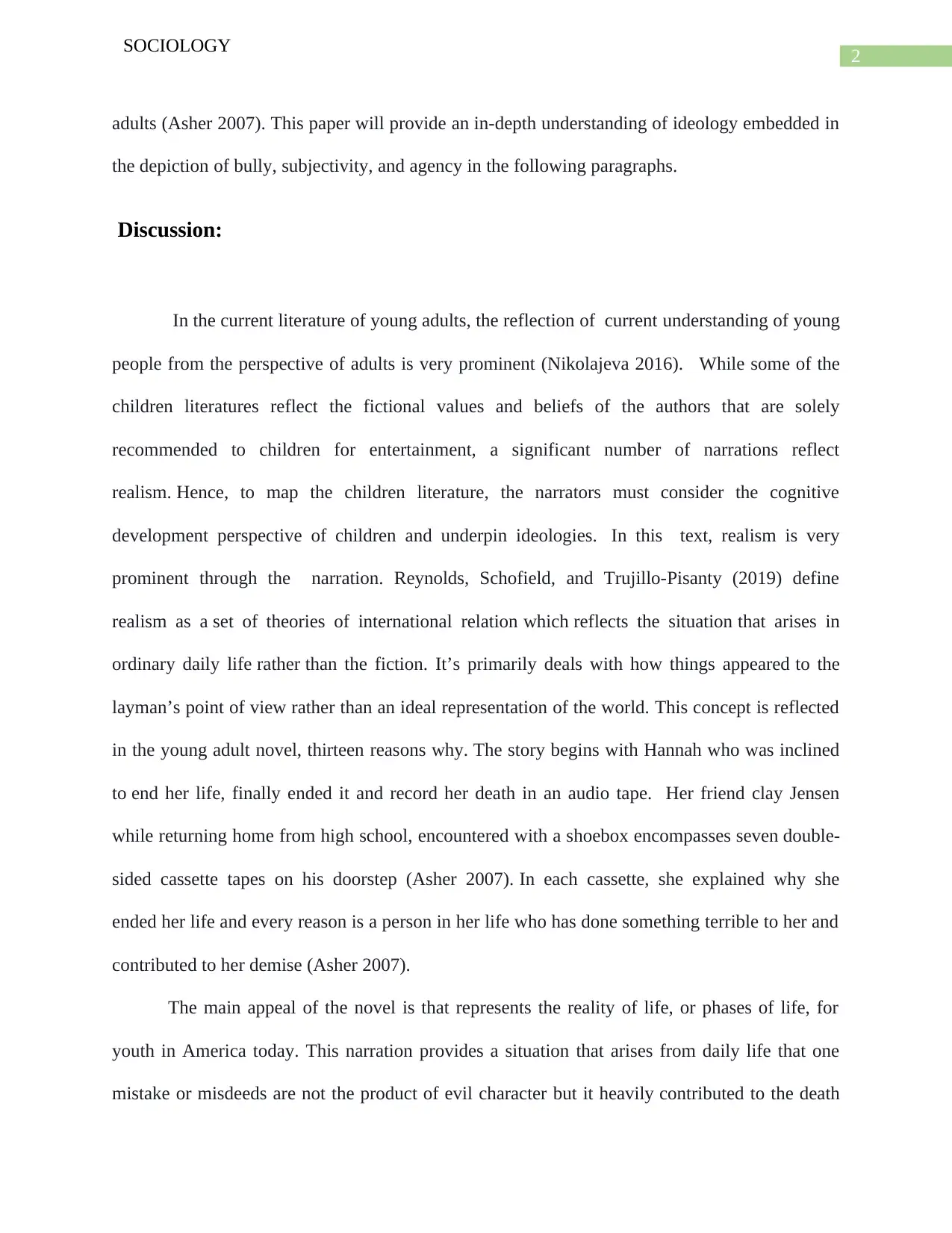
2
SOCIOLOGY
adults (Asher 2007). This paper will provide an in-depth understanding of ideology embedded in
the depiction of bully, subjectivity, and agency in the following paragraphs.
Discussion:
In the current literature of young adults, the reflection of current understanding of young
people from the perspective of adults is very prominent (Nikolajeva 2016). While some of the
children literatures reflect the fictional values and beliefs of the authors that are solely
recommended to children for entertainment, a significant number of narrations reflect
realism. Hence, to map the children literature, the narrators must consider the cognitive
development perspective of children and underpin ideologies. In this text, realism is very
prominent through the narration. Reynolds, Schofield, and Trujillo-Pisanty (2019) define
realism as a set of theories of international relation which reflects the situation that arises in
ordinary daily life rather than the fiction. It’s primarily deals with how things appeared to the
layman’s point of view rather than an ideal representation of the world. This concept is reflected
in the young adult novel, thirteen reasons why. The story begins with Hannah who was inclined
to end her life, finally ended it and record her death in an audio tape. Her friend clay Jensen
while returning home from high school, encountered with a shoebox encompasses seven double-
sided cassette tapes on his doorstep (Asher 2007). In each cassette, she explained why she
ended her life and every reason is a person in her life who has done something terrible to her and
contributed to her demise (Asher 2007).
The main appeal of the novel is that represents the reality of life, or phases of life, for
youth in America today. This narration provides a situation that arises from daily life that one
mistake or misdeeds are not the product of evil character but it heavily contributed to the death
SOCIOLOGY
adults (Asher 2007). This paper will provide an in-depth understanding of ideology embedded in
the depiction of bully, subjectivity, and agency in the following paragraphs.
Discussion:
In the current literature of young adults, the reflection of current understanding of young
people from the perspective of adults is very prominent (Nikolajeva 2016). While some of the
children literatures reflect the fictional values and beliefs of the authors that are solely
recommended to children for entertainment, a significant number of narrations reflect
realism. Hence, to map the children literature, the narrators must consider the cognitive
development perspective of children and underpin ideologies. In this text, realism is very
prominent through the narration. Reynolds, Schofield, and Trujillo-Pisanty (2019) define
realism as a set of theories of international relation which reflects the situation that arises in
ordinary daily life rather than the fiction. It’s primarily deals with how things appeared to the
layman’s point of view rather than an ideal representation of the world. This concept is reflected
in the young adult novel, thirteen reasons why. The story begins with Hannah who was inclined
to end her life, finally ended it and record her death in an audio tape. Her friend clay Jensen
while returning home from high school, encountered with a shoebox encompasses seven double-
sided cassette tapes on his doorstep (Asher 2007). In each cassette, she explained why she
ended her life and every reason is a person in her life who has done something terrible to her and
contributed to her demise (Asher 2007).
The main appeal of the novel is that represents the reality of life, or phases of life, for
youth in America today. This narration provides a situation that arises from daily life that one
mistake or misdeeds are not the product of evil character but it heavily contributed to the death
⊘ This is a preview!⊘
Do you want full access?
Subscribe today to unlock all pages.

Trusted by 1+ million students worldwide

3
SOCIOLOGY
(Till et al. 2016). At this juncture, it is crucial to mention that this kind of narration further
influences the construction of identity. The postmodern perspective of identity highlighted that
society plays a crucial role in the formation of identity which further reflected through this novel
(Reynolds, Schofield and Trujillo-Pisanty 2019). In the literature, the ideology includes the
larger scale of political economic and cultural ideas such as democracy, christianity and
capitalism along with individualism dominate the western world (Bradford 2011). In the text,
the passive or unconscious ideology was very prominent which further play a role in shaping the
identity of the young adults. Polar Hollandale defines unconscious or passive ideology as a way
of constructing text to convey surface ideology and may reveal common cultural and social
assumptions about gender, race, class sexuality and disability (Hollindale 2003). In the text 13
reasons why, issue of rape and sexual assault is a major theme and suggested many social and
cultural factors of immaturity, alcoholism, general confusion and naiveté which leads to
destruction. Suicide is one of the most common amongst youth and considered as the most tragic
symptoms of terminally decayed social order. Through the text, the narrator also showed that the
athletes are considered as the hero of the high school and their achievements are celebrated
drastically throughout the high school, highlighting organic ideology of the author. Hence, in this
text, the narrator not only reveal the identity of young girls, gender stereotypes and but also
provide an awareness of how social and cultural issues may impact lives (Ma 2017). While some
of the adolescent’s readers will develop values and beliefs according to it, some of the readers
would be aware of their identity and values and will be aware of their identity formation (Te'eni-
Harari and Eyal 2015). This text of children literature also provides awareness to the parents
regarding the mental health of their children.
SOCIOLOGY
(Till et al. 2016). At this juncture, it is crucial to mention that this kind of narration further
influences the construction of identity. The postmodern perspective of identity highlighted that
society plays a crucial role in the formation of identity which further reflected through this novel
(Reynolds, Schofield and Trujillo-Pisanty 2019). In the literature, the ideology includes the
larger scale of political economic and cultural ideas such as democracy, christianity and
capitalism along with individualism dominate the western world (Bradford 2011). In the text,
the passive or unconscious ideology was very prominent which further play a role in shaping the
identity of the young adults. Polar Hollandale defines unconscious or passive ideology as a way
of constructing text to convey surface ideology and may reveal common cultural and social
assumptions about gender, race, class sexuality and disability (Hollindale 2003). In the text 13
reasons why, issue of rape and sexual assault is a major theme and suggested many social and
cultural factors of immaturity, alcoholism, general confusion and naiveté which leads to
destruction. Suicide is one of the most common amongst youth and considered as the most tragic
symptoms of terminally decayed social order. Through the text, the narrator also showed that the
athletes are considered as the hero of the high school and their achievements are celebrated
drastically throughout the high school, highlighting organic ideology of the author. Hence, in this
text, the narrator not only reveal the identity of young girls, gender stereotypes and but also
provide an awareness of how social and cultural issues may impact lives (Ma 2017). While some
of the adolescent’s readers will develop values and beliefs according to it, some of the readers
would be aware of their identity and values and will be aware of their identity formation (Te'eni-
Harari and Eyal 2015). This text of children literature also provides awareness to the parents
regarding the mental health of their children.
Paraphrase This Document
Need a fresh take? Get an instant paraphrase of this document with our AI Paraphraser
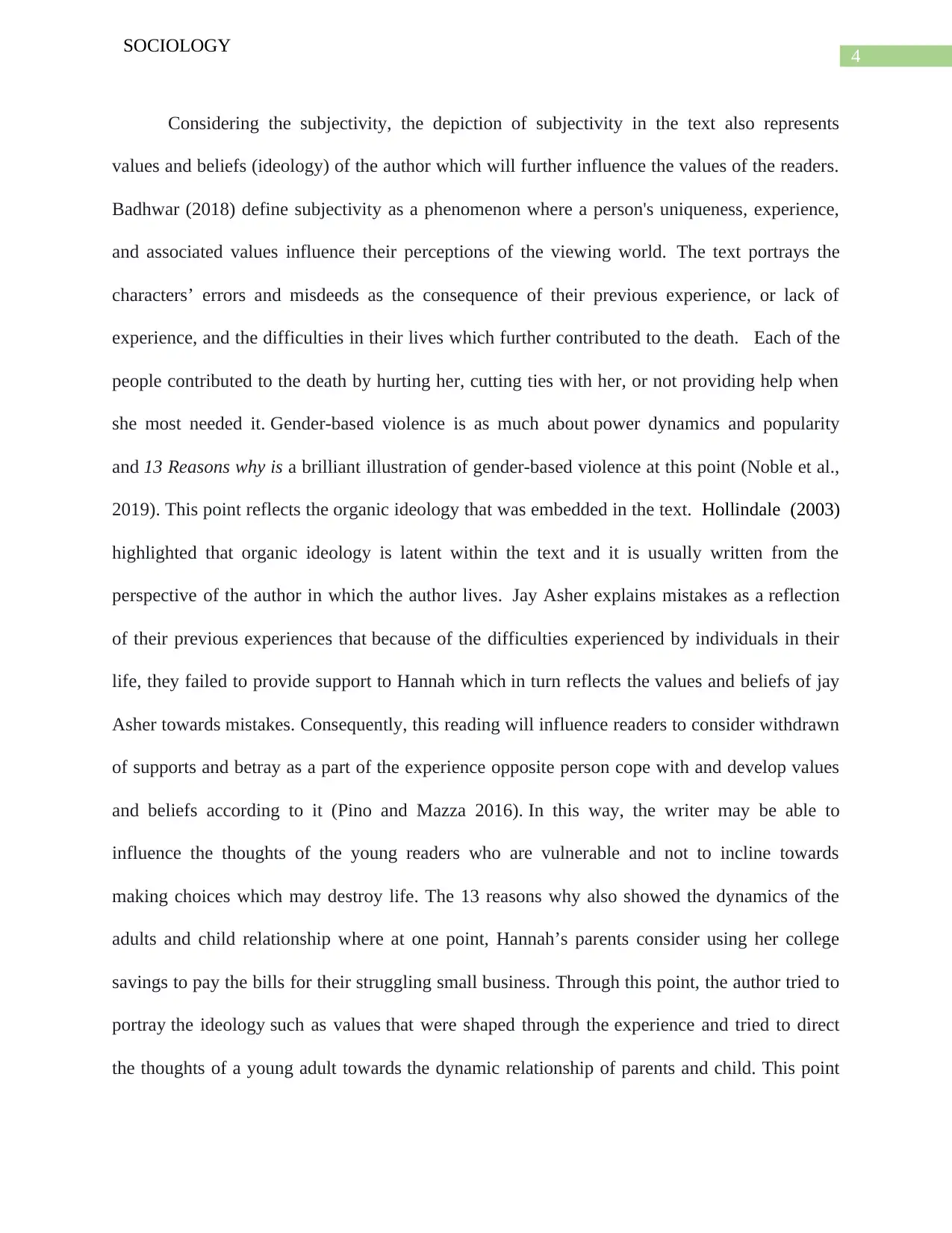
4
SOCIOLOGY
Considering the subjectivity, the depiction of subjectivity in the text also represents
values and beliefs (ideology) of the author which will further influence the values of the readers.
Badhwar (2018) define subjectivity as a phenomenon where a person's uniqueness, experience,
and associated values influence their perceptions of the viewing world. The text portrays the
characters’ errors and misdeeds as the consequence of their previous experience, or lack of
experience, and the difficulties in their lives which further contributed to the death. Each of the
people contributed to the death by hurting her, cutting ties with her, or not providing help when
she most needed it. Gender-based violence is as much about power dynamics and popularity
and 13 Reasons why is a brilliant illustration of gender-based violence at this point (Noble et al.,
2019). This point reflects the organic ideology that was embedded in the text. Hollindale (2003)
highlighted that organic ideology is latent within the text and it is usually written from the
perspective of the author in which the author lives. Jay Asher explains mistakes as a reflection
of their previous experiences that because of the difficulties experienced by individuals in their
life, they failed to provide support to Hannah which in turn reflects the values and beliefs of jay
Asher towards mistakes. Consequently, this reading will influence readers to consider withdrawn
of supports and betray as a part of the experience opposite person cope with and develop values
and beliefs according to it (Pino and Mazza 2016). In this way, the writer may be able to
influence the thoughts of the young readers who are vulnerable and not to incline towards
making choices which may destroy life. The 13 reasons why also showed the dynamics of the
adults and child relationship where at one point, Hannah’s parents consider using her college
savings to pay the bills for their struggling small business. Through this point, the author tried to
portray the ideology such as values that were shaped through the experience and tried to direct
the thoughts of a young adult towards the dynamic relationship of parents and child. This point
SOCIOLOGY
Considering the subjectivity, the depiction of subjectivity in the text also represents
values and beliefs (ideology) of the author which will further influence the values of the readers.
Badhwar (2018) define subjectivity as a phenomenon where a person's uniqueness, experience,
and associated values influence their perceptions of the viewing world. The text portrays the
characters’ errors and misdeeds as the consequence of their previous experience, or lack of
experience, and the difficulties in their lives which further contributed to the death. Each of the
people contributed to the death by hurting her, cutting ties with her, or not providing help when
she most needed it. Gender-based violence is as much about power dynamics and popularity
and 13 Reasons why is a brilliant illustration of gender-based violence at this point (Noble et al.,
2019). This point reflects the organic ideology that was embedded in the text. Hollindale (2003)
highlighted that organic ideology is latent within the text and it is usually written from the
perspective of the author in which the author lives. Jay Asher explains mistakes as a reflection
of their previous experiences that because of the difficulties experienced by individuals in their
life, they failed to provide support to Hannah which in turn reflects the values and beliefs of jay
Asher towards mistakes. Consequently, this reading will influence readers to consider withdrawn
of supports and betray as a part of the experience opposite person cope with and develop values
and beliefs according to it (Pino and Mazza 2016). In this way, the writer may be able to
influence the thoughts of the young readers who are vulnerable and not to incline towards
making choices which may destroy life. The 13 reasons why also showed the dynamics of the
adults and child relationship where at one point, Hannah’s parents consider using her college
savings to pay the bills for their struggling small business. Through this point, the author tried to
portray the ideology such as values that were shaped through the experience and tried to direct
the thoughts of a young adult towards the dynamic relationship of parents and child. This point
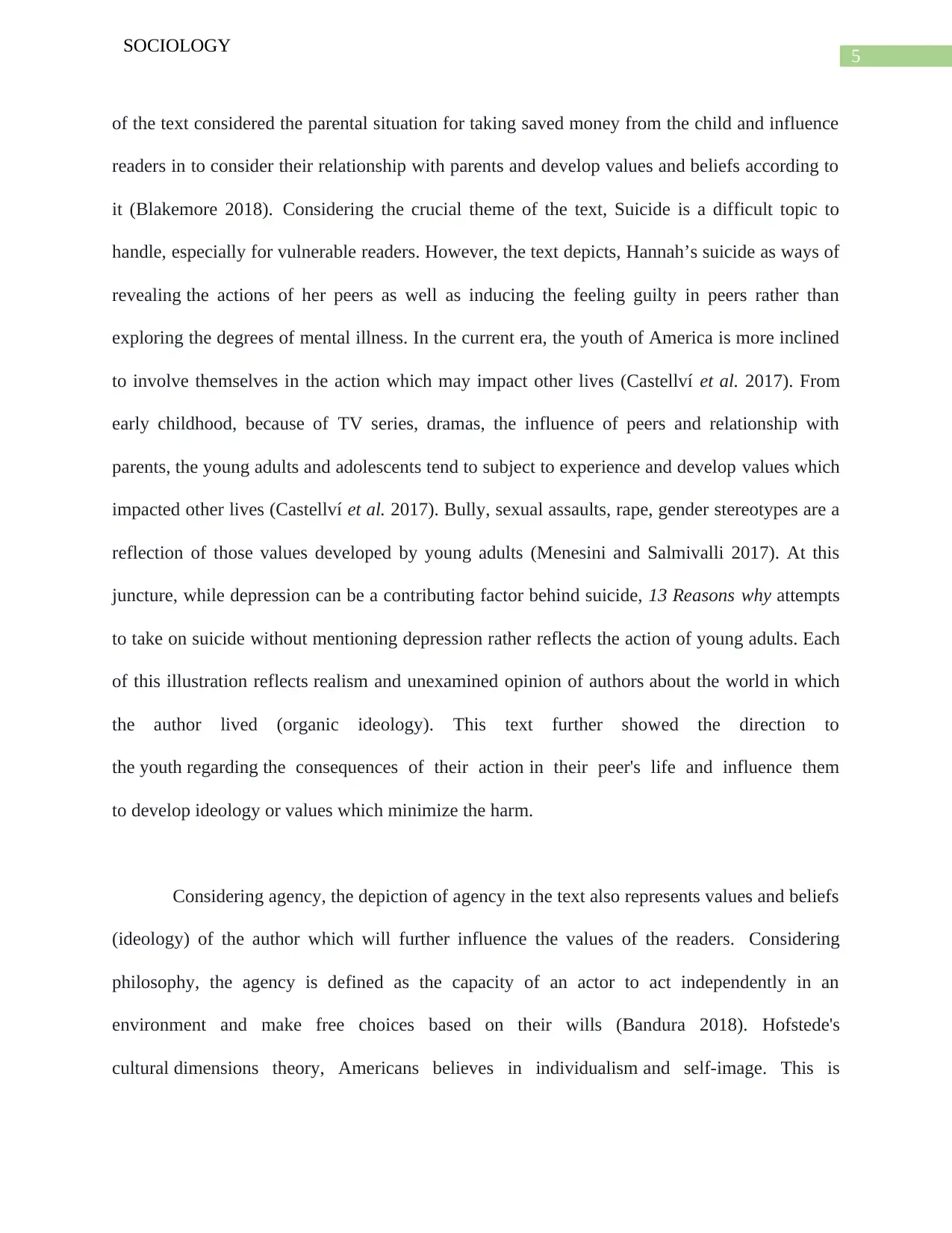
5
SOCIOLOGY
of the text considered the parental situation for taking saved money from the child and influence
readers in to consider their relationship with parents and develop values and beliefs according to
it (Blakemore 2018). Considering the crucial theme of the text, Suicide is a difficult topic to
handle, especially for vulnerable readers. However, the text depicts, Hannah’s suicide as ways of
revealing the actions of her peers as well as inducing the feeling guilty in peers rather than
exploring the degrees of mental illness. In the current era, the youth of America is more inclined
to involve themselves in the action which may impact other lives (Castellví et al. 2017). From
early childhood, because of TV series, dramas, the influence of peers and relationship with
parents, the young adults and adolescents tend to subject to experience and develop values which
impacted other lives (Castellví et al. 2017). Bully, sexual assaults, rape, gender stereotypes are a
reflection of those values developed by young adults (Menesini and Salmivalli 2017). At this
juncture, while depression can be a contributing factor behind suicide, 13 Reasons why attempts
to take on suicide without mentioning depression rather reflects the action of young adults. Each
of this illustration reflects realism and unexamined opinion of authors about the world in which
the author lived (organic ideology). This text further showed the direction to
the youth regarding the consequences of their action in their peer's life and influence them
to develop ideology or values which minimize the harm.
Considering agency, the depiction of agency in the text also represents values and beliefs
(ideology) of the author which will further influence the values of the readers. Considering
philosophy, the agency is defined as the capacity of an actor to act independently in an
environment and make free choices based on their wills (Bandura 2018). Hofstede's
cultural dimensions theory, Americans believes in individualism and self-image. This is
SOCIOLOGY
of the text considered the parental situation for taking saved money from the child and influence
readers in to consider their relationship with parents and develop values and beliefs according to
it (Blakemore 2018). Considering the crucial theme of the text, Suicide is a difficult topic to
handle, especially for vulnerable readers. However, the text depicts, Hannah’s suicide as ways of
revealing the actions of her peers as well as inducing the feeling guilty in peers rather than
exploring the degrees of mental illness. In the current era, the youth of America is more inclined
to involve themselves in the action which may impact other lives (Castellví et al. 2017). From
early childhood, because of TV series, dramas, the influence of peers and relationship with
parents, the young adults and adolescents tend to subject to experience and develop values which
impacted other lives (Castellví et al. 2017). Bully, sexual assaults, rape, gender stereotypes are a
reflection of those values developed by young adults (Menesini and Salmivalli 2017). At this
juncture, while depression can be a contributing factor behind suicide, 13 Reasons why attempts
to take on suicide without mentioning depression rather reflects the action of young adults. Each
of this illustration reflects realism and unexamined opinion of authors about the world in which
the author lived (organic ideology). This text further showed the direction to
the youth regarding the consequences of their action in their peer's life and influence them
to develop ideology or values which minimize the harm.
Considering agency, the depiction of agency in the text also represents values and beliefs
(ideology) of the author which will further influence the values of the readers. Considering
philosophy, the agency is defined as the capacity of an actor to act independently in an
environment and make free choices based on their wills (Bandura 2018). Hofstede's
cultural dimensions theory, Americans believes in individualism and self-image. This is
⊘ This is a preview!⊘
Do you want full access?
Subscribe today to unlock all pages.

Trusted by 1+ million students worldwide
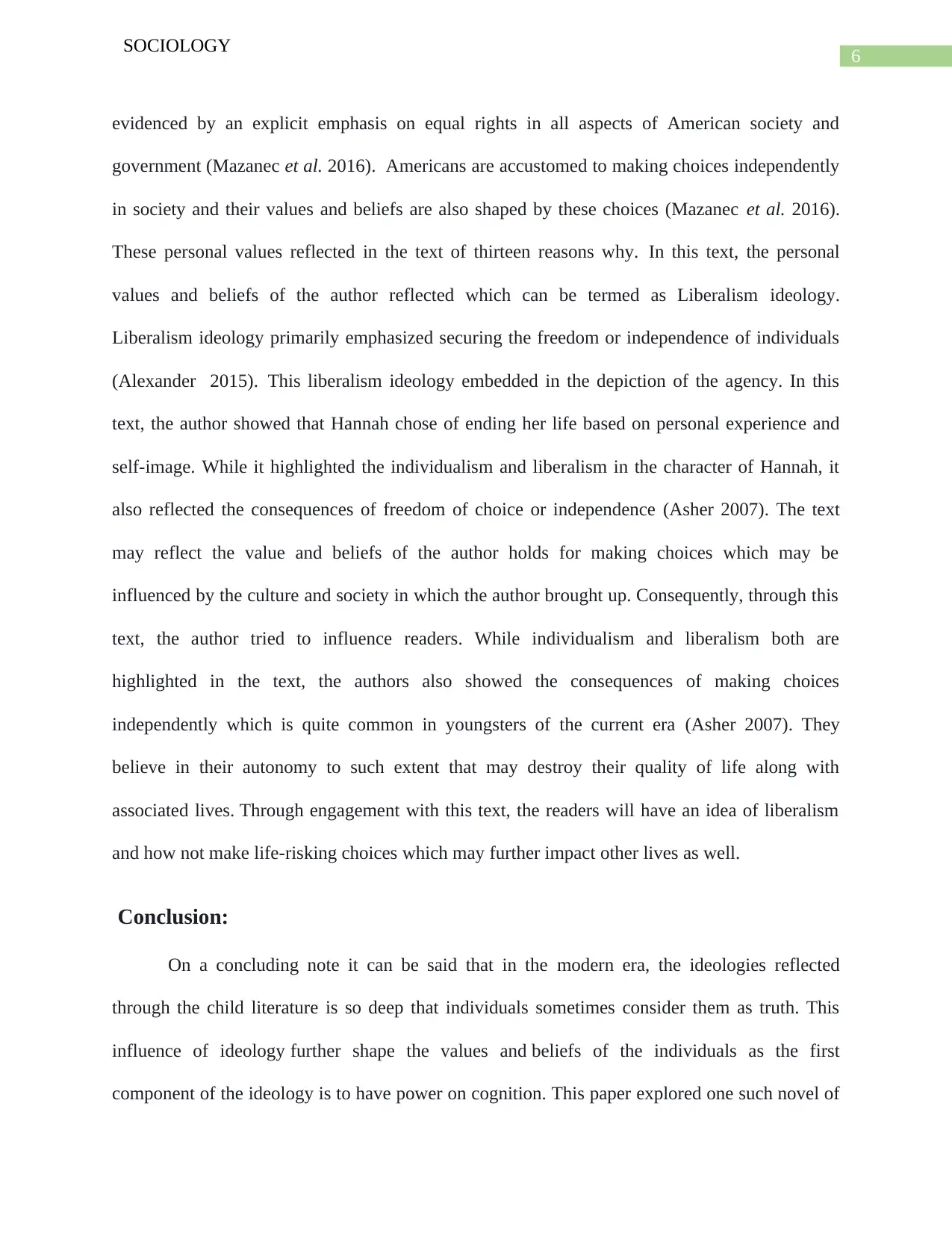
6
SOCIOLOGY
evidenced by an explicit emphasis on equal rights in all aspects of American society and
government (Mazanec et al. 2016). Americans are accustomed to making choices independently
in society and their values and beliefs are also shaped by these choices (Mazanec et al. 2016).
These personal values reflected in the text of thirteen reasons why. In this text, the personal
values and beliefs of the author reflected which can be termed as Liberalism ideology.
Liberalism ideology primarily emphasized securing the freedom or independence of individuals
(Alexander 2015). This liberalism ideology embedded in the depiction of the agency. In this
text, the author showed that Hannah chose of ending her life based on personal experience and
self-image. While it highlighted the individualism and liberalism in the character of Hannah, it
also reflected the consequences of freedom of choice or independence (Asher 2007). The text
may reflect the value and beliefs of the author holds for making choices which may be
influenced by the culture and society in which the author brought up. Consequently, through this
text, the author tried to influence readers. While individualism and liberalism both are
highlighted in the text, the authors also showed the consequences of making choices
independently which is quite common in youngsters of the current era (Asher 2007). They
believe in their autonomy to such extent that may destroy their quality of life along with
associated lives. Through engagement with this text, the readers will have an idea of liberalism
and how not make life-risking choices which may further impact other lives as well.
Conclusion:
On a concluding note it can be said that in the modern era, the ideologies reflected
through the child literature is so deep that individuals sometimes consider them as truth. This
influence of ideology further shape the values and beliefs of the individuals as the first
component of the ideology is to have power on cognition. This paper explored one such novel of
SOCIOLOGY
evidenced by an explicit emphasis on equal rights in all aspects of American society and
government (Mazanec et al. 2016). Americans are accustomed to making choices independently
in society and their values and beliefs are also shaped by these choices (Mazanec et al. 2016).
These personal values reflected in the text of thirteen reasons why. In this text, the personal
values and beliefs of the author reflected which can be termed as Liberalism ideology.
Liberalism ideology primarily emphasized securing the freedom or independence of individuals
(Alexander 2015). This liberalism ideology embedded in the depiction of the agency. In this
text, the author showed that Hannah chose of ending her life based on personal experience and
self-image. While it highlighted the individualism and liberalism in the character of Hannah, it
also reflected the consequences of freedom of choice or independence (Asher 2007). The text
may reflect the value and beliefs of the author holds for making choices which may be
influenced by the culture and society in which the author brought up. Consequently, through this
text, the author tried to influence readers. While individualism and liberalism both are
highlighted in the text, the authors also showed the consequences of making choices
independently which is quite common in youngsters of the current era (Asher 2007). They
believe in their autonomy to such extent that may destroy their quality of life along with
associated lives. Through engagement with this text, the readers will have an idea of liberalism
and how not make life-risking choices which may further impact other lives as well.
Conclusion:
On a concluding note it can be said that in the modern era, the ideologies reflected
through the child literature is so deep that individuals sometimes consider them as truth. This
influence of ideology further shape the values and beliefs of the individuals as the first
component of the ideology is to have power on cognition. This paper explored one such novel of
Paraphrase This Document
Need a fresh take? Get an instant paraphrase of this document with our AI Paraphraser
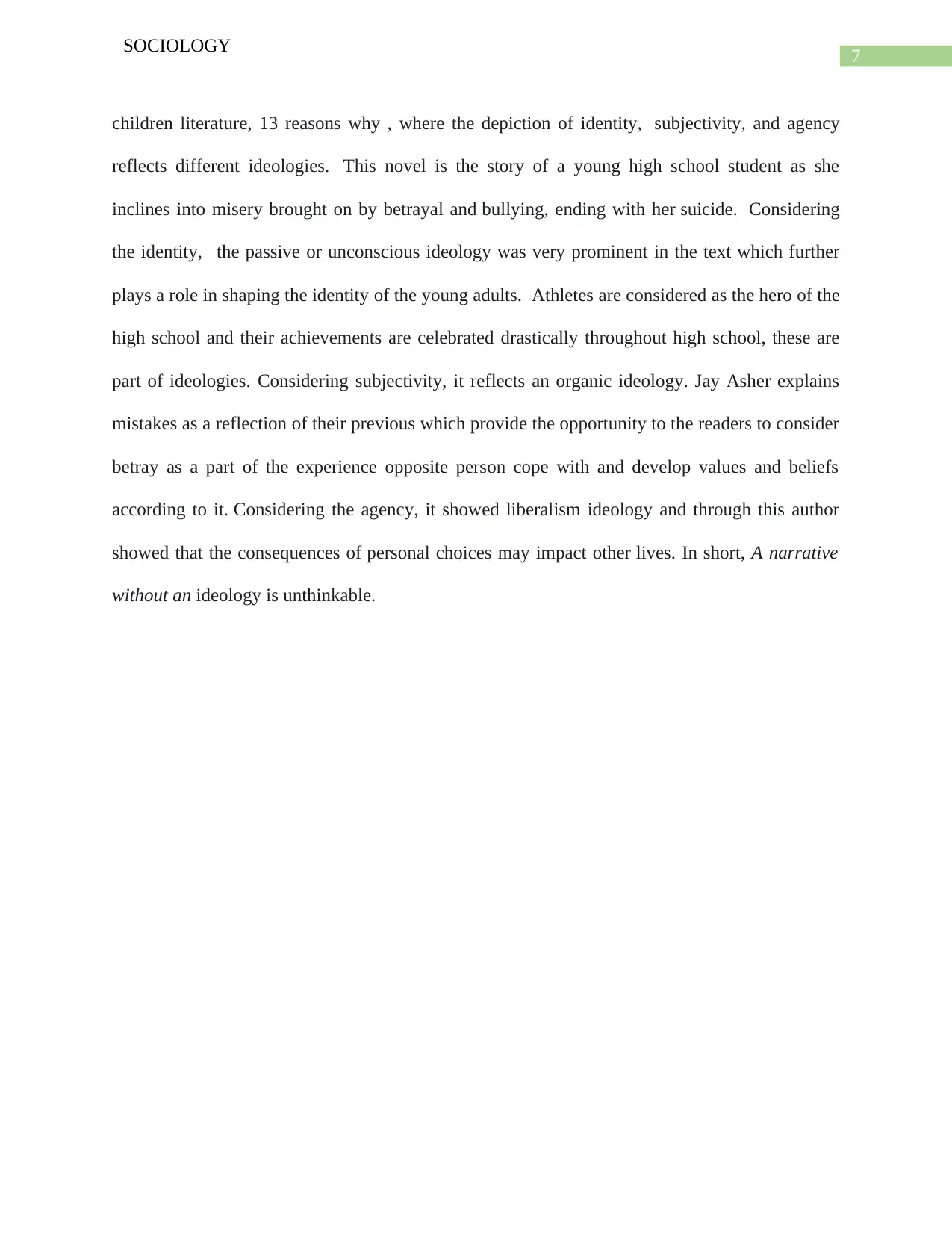
7
SOCIOLOGY
children literature, 13 reasons why , where the depiction of identity, subjectivity, and agency
reflects different ideologies. This novel is the story of a young high school student as she
inclines into misery brought on by betrayal and bullying, ending with her suicide. Considering
the identity, the passive or unconscious ideology was very prominent in the text which further
plays a role in shaping the identity of the young adults. Athletes are considered as the hero of the
high school and their achievements are celebrated drastically throughout high school, these are
part of ideologies. Considering subjectivity, it reflects an organic ideology. Jay Asher explains
mistakes as a reflection of their previous which provide the opportunity to the readers to consider
betray as a part of the experience opposite person cope with and develop values and beliefs
according to it. Considering the agency, it showed liberalism ideology and through this author
showed that the consequences of personal choices may impact other lives. In short, A narrative
without an ideology is unthinkable.
SOCIOLOGY
children literature, 13 reasons why , where the depiction of identity, subjectivity, and agency
reflects different ideologies. This novel is the story of a young high school student as she
inclines into misery brought on by betrayal and bullying, ending with her suicide. Considering
the identity, the passive or unconscious ideology was very prominent in the text which further
plays a role in shaping the identity of the young adults. Athletes are considered as the hero of the
high school and their achievements are celebrated drastically throughout high school, these are
part of ideologies. Considering subjectivity, it reflects an organic ideology. Jay Asher explains
mistakes as a reflection of their previous which provide the opportunity to the readers to consider
betray as a part of the experience opposite person cope with and develop values and beliefs
according to it. Considering the agency, it showed liberalism ideology and through this author
showed that the consequences of personal choices may impact other lives. In short, A narrative
without an ideology is unthinkable.

8
SOCIOLOGY
References:
Alexander, J., 2015. The major ideologies of liberalism, socialism and conservatism. Political
Studies, 63(5), pp.980-994.
Asher, j 2007. Thirteen reasons why. Razorbill. New York
Badhwar, N., 2018. Objectivity and subjectivity in theories of well-being. Philosophy and
Public Policy Quarterly, 32(1), pp.23-28.
Bandura, A., 2018. Toward a psychology of human agency: Pathways and
reflections. Perspectives on Psychological Science, 13(2), pp.130-136.
Blakemore, S.J., 2018. Avoiding social risk in adolescence. Current directions in psychological
science, 27(2), pp.116-122.
Bradford, C. 2011. Reading indigeneity: The ethics of interpretation and
representation. Handbook of research on children’s and young adult literature, 331-42.
Castellví, P., Lucas-Romero, E., Miranda-Mendizábal, A., Parés-Badell, O., Almenara, J.,
Alonso, I., Blasco, M.J., Cebrià, A., Gabilondo, A., Gili, M. and Lagares, C., 2017. Longitudinal
association between self-injurious thoughts and behaviors and suicidal behavior in adolescents
and young adults: A systematic review with meta-analysis. Journal of affective disorders, 215,
pp.37-48.
Hollindale, P. 2003 . Ideology and the Children's Book. In P Hunt (ed). Literature for children:
contemporary criticism. Routledge. London , pp: 19 -40.
Kaniklidou, T. and House, J., 2018. Discourse and ideology in translated children’s literature: a
comparative study. Perspectives, 26(2), pp.232-245.
Ma, Z., 2017. How the media cover mental illnesses: a review. Health Education, 117(1), pp.90-
109.
SOCIOLOGY
References:
Alexander, J., 2015. The major ideologies of liberalism, socialism and conservatism. Political
Studies, 63(5), pp.980-994.
Asher, j 2007. Thirteen reasons why. Razorbill. New York
Badhwar, N., 2018. Objectivity and subjectivity in theories of well-being. Philosophy and
Public Policy Quarterly, 32(1), pp.23-28.
Bandura, A., 2018. Toward a psychology of human agency: Pathways and
reflections. Perspectives on Psychological Science, 13(2), pp.130-136.
Blakemore, S.J., 2018. Avoiding social risk in adolescence. Current directions in psychological
science, 27(2), pp.116-122.
Bradford, C. 2011. Reading indigeneity: The ethics of interpretation and
representation. Handbook of research on children’s and young adult literature, 331-42.
Castellví, P., Lucas-Romero, E., Miranda-Mendizábal, A., Parés-Badell, O., Almenara, J.,
Alonso, I., Blasco, M.J., Cebrià, A., Gabilondo, A., Gili, M. and Lagares, C., 2017. Longitudinal
association between self-injurious thoughts and behaviors and suicidal behavior in adolescents
and young adults: A systematic review with meta-analysis. Journal of affective disorders, 215,
pp.37-48.
Hollindale, P. 2003 . Ideology and the Children's Book. In P Hunt (ed). Literature for children:
contemporary criticism. Routledge. London , pp: 19 -40.
Kaniklidou, T. and House, J., 2018. Discourse and ideology in translated children’s literature: a
comparative study. Perspectives, 26(2), pp.232-245.
Ma, Z., 2017. How the media cover mental illnesses: a review. Health Education, 117(1), pp.90-
109.
⊘ This is a preview!⊘
Do you want full access?
Subscribe today to unlock all pages.

Trusted by 1+ million students worldwide
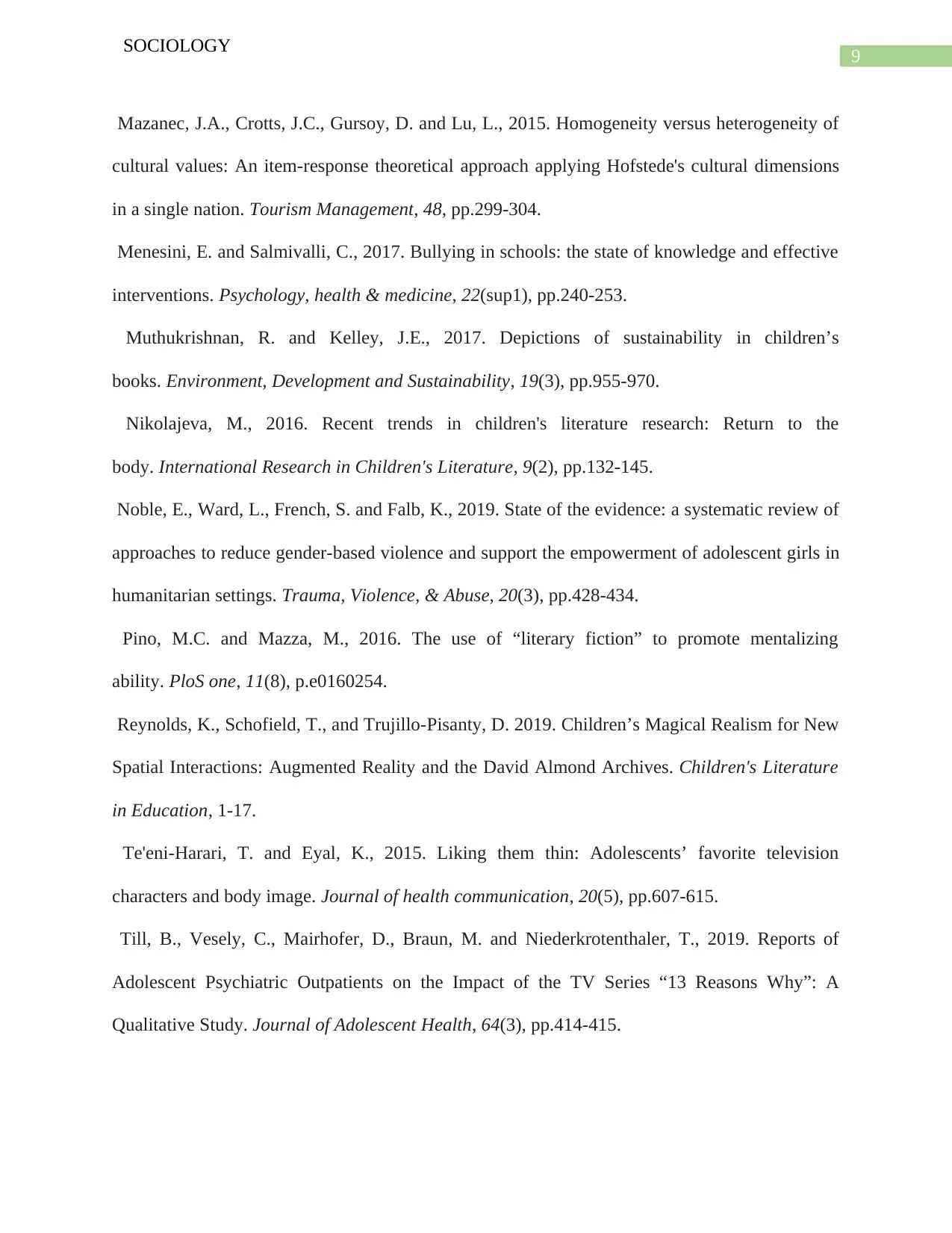
9
SOCIOLOGY
Mazanec, J.A., Crotts, J.C., Gursoy, D. and Lu, L., 2015. Homogeneity versus heterogeneity of
cultural values: An item-response theoretical approach applying Hofstede's cultural dimensions
in a single nation. Tourism Management, 48, pp.299-304.
Menesini, E. and Salmivalli, C., 2017. Bullying in schools: the state of knowledge and effective
interventions. Psychology, health & medicine, 22(sup1), pp.240-253.
Muthukrishnan, R. and Kelley, J.E., 2017. Depictions of sustainability in children’s
books. Environment, Development and Sustainability, 19(3), pp.955-970.
Nikolajeva, M., 2016. Recent trends in children's literature research: Return to the
body. International Research in Children's Literature, 9(2), pp.132-145.
Noble, E., Ward, L., French, S. and Falb, K., 2019. State of the evidence: a systematic review of
approaches to reduce gender-based violence and support the empowerment of adolescent girls in
humanitarian settings. Trauma, Violence, & Abuse, 20(3), pp.428-434.
Pino, M.C. and Mazza, M., 2016. The use of “literary fiction” to promote mentalizing
ability. PloS one, 11(8), p.e0160254.
Reynolds, K., Schofield, T., and Trujillo-Pisanty, D. 2019. Children’s Magical Realism for New
Spatial Interactions: Augmented Reality and the David Almond Archives. Children's Literature
in Education, 1-17.
Te'eni-Harari, T. and Eyal, K., 2015. Liking them thin: Adolescents’ favorite television
characters and body image. Journal of health communication, 20(5), pp.607-615.
Till, B., Vesely, C., Mairhofer, D., Braun, M. and Niederkrotenthaler, T., 2019. Reports of
Adolescent Psychiatric Outpatients on the Impact of the TV Series “13 Reasons Why”: A
Qualitative Study. Journal of Adolescent Health, 64(3), pp.414-415.
SOCIOLOGY
Mazanec, J.A., Crotts, J.C., Gursoy, D. and Lu, L., 2015. Homogeneity versus heterogeneity of
cultural values: An item-response theoretical approach applying Hofstede's cultural dimensions
in a single nation. Tourism Management, 48, pp.299-304.
Menesini, E. and Salmivalli, C., 2017. Bullying in schools: the state of knowledge and effective
interventions. Psychology, health & medicine, 22(sup1), pp.240-253.
Muthukrishnan, R. and Kelley, J.E., 2017. Depictions of sustainability in children’s
books. Environment, Development and Sustainability, 19(3), pp.955-970.
Nikolajeva, M., 2016. Recent trends in children's literature research: Return to the
body. International Research in Children's Literature, 9(2), pp.132-145.
Noble, E., Ward, L., French, S. and Falb, K., 2019. State of the evidence: a systematic review of
approaches to reduce gender-based violence and support the empowerment of adolescent girls in
humanitarian settings. Trauma, Violence, & Abuse, 20(3), pp.428-434.
Pino, M.C. and Mazza, M., 2016. The use of “literary fiction” to promote mentalizing
ability. PloS one, 11(8), p.e0160254.
Reynolds, K., Schofield, T., and Trujillo-Pisanty, D. 2019. Children’s Magical Realism for New
Spatial Interactions: Augmented Reality and the David Almond Archives. Children's Literature
in Education, 1-17.
Te'eni-Harari, T. and Eyal, K., 2015. Liking them thin: Adolescents’ favorite television
characters and body image. Journal of health communication, 20(5), pp.607-615.
Till, B., Vesely, C., Mairhofer, D., Braun, M. and Niederkrotenthaler, T., 2019. Reports of
Adolescent Psychiatric Outpatients on the Impact of the TV Series “13 Reasons Why”: A
Qualitative Study. Journal of Adolescent Health, 64(3), pp.414-415.
1 out of 10
Your All-in-One AI-Powered Toolkit for Academic Success.
+13062052269
info@desklib.com
Available 24*7 on WhatsApp / Email
![[object Object]](/_next/static/media/star-bottom.7253800d.svg)
Unlock your academic potential
Copyright © 2020–2025 A2Z Services. All Rights Reserved. Developed and managed by ZUCOL.